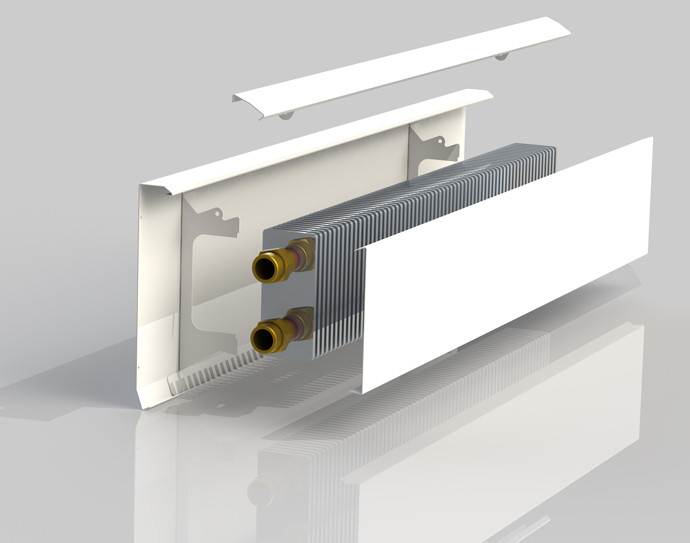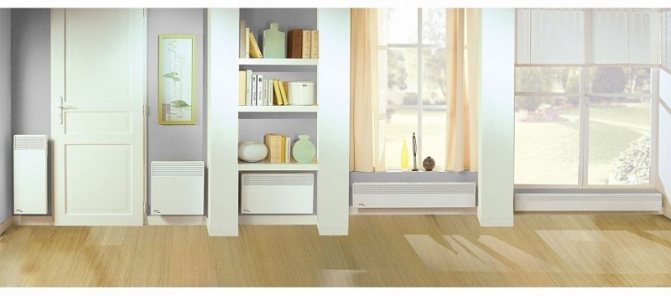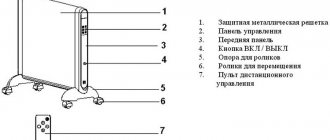You can maintain a comfortable temperature in your apartment or house in different ways - using electric convectors, infrared heaters, autonomous water heating, etc. In this article we will try to figure out what a skirting convector is. Such devices appeared on the market of thermal devices not so long ago, therefore, they are still little known to most users.
Wall and floor heating devices are more common in this regard, but their main drawbacks are their large dimensions and high energy consumption. The main advantages of skirting-type convectors are their miniature size and full compatibility with the previously chosen interior of the room they will heat.

What is a skirting convector
Heating devices that create conditions for natural air convection inside the room are presented in hundreds of models.
They differ from each other:
- design features;
- functionality;
- power consumption and many other parameters.
When choosing such equipment, it is often necessary either to close our eyes to individual characteristics of the device, focusing on the aesthetic design and dimensions of the product, or to focus on its technical parameters, leaving the appearance outside the brackets.
Autonomous heating devices are universal in this respect. They not only provide effective heating of air in the room, but also look presentable. The miniature size of the devices allows them to be placed at a short distance from the floor and to be decorated under a regular skirting board.


Device
The first thing that is noticeable when getting acquainted with heaters of this type is the device body. Due to its size and design, it fits perfectly into the environment of the room and practically does not focus on itself.
In reality, this is a well-decorated autonomous heating system, in the body of which the main component of the structure is located - the heating element. It is represented by an electric heating element or a copper radiator, through the tubes of which water circulates, heated to a certain temperature.
It is when cold air comes into contact with it that the convective movement of air masses known to us from a school physics course is launched. It should be noted that the external design of the heater carries not only an aesthetic, but also a functional load.
The body of the device is equipped with special slotted holes, the task of which is to release the heated air outside and take cold masses inside the convector. Its front panel is equipped with a decorative openwork grille.
This method of technical design is widely used in most modern convection-type heating devices - its upper part radiates heat, and the lower one ensures the unhindered penetration of cold air into the heating zone.
Thanks to this design, autonomous skirting board heating not only effectively warms up the interior space, but is also perceived by others as a well-chosen piece of furniture.


How does it work
A convector is a heating device, the principle of which is based on the radiation of heat waves that cause natural movement of air masses of different temperatures inside the heated room.
An electric heating element or a heat exchanger located inside the body of the device heats up the air, which, rushing upwards, displaces the masses of a lower temperature to the floor level. Below, falling into the range of the device, they heat up and rise again to the ceiling.
Due to natural circulation, the room space gradually gains a predetermined temperature.
Features:
- If the device is equipped with an automatic thermostat, then at the moment the set value is reached, the heating element is switched to an economical mode of operation or is turned off altogether.
- When the temperature indicator decreases, the heat supply resumes, restarting the convection process.


Where is applied
The skirting-type convector belongs to the devices that are most often used for heating private and commercial premises, where there is no possibility of using traditional heating options.
These include buildings in which:
- gas supply is not provided;
- there is no possibility to use the centralized heating system.
The segment of compact heating systems remains in demand among apartment owners in multi-storey buildings.
This is due to the fact that such equipment:
- does not require a lot of space;
- does not enter into dissonance with the interior of the rooms;
- fully provides heat to the heated area.
Sometimes the need for miniature heating devices arises when you want to get rid of bulky water radiators. In this case, miniature convectors are the most suitable option, since they can be used instead of conventional batteries.
Manufacturers produce models of devices specifically designed to create a microclimate in:
- winter gardens;
- greenhouses;
- greenhouses;
- children's rooms;
- other living quarters of a house or apartment.
They differ in the length of the radiated surface and the power.
In short, baseboard heating systems are versatile and can be used in any conditions. If the issue of the lack of power of the device does not play a special role for you, then such equipment may well be used as the only source of heating the room.


pros
We have already noted that the main advantage of skirting-type convectors is their compactness. The height of such devices ranges from 60 to 250 mm, and the thickness does not exceed 100 mm.
In addition, the distinctive features of such devices include:
- high speed of heating the room - due to the constant circulation of air flows, the room heats up within 20-30 minutes;
- safety during operation - the equipment has reliable protection against accidental contact with heating elements, which makes it possible to use it even in rooms for children;
- the ability to create a comfortable temperature in rooms with any ceiling height - with ordinary heating devices, as a rule, the bottom of the room does not warm up well, the proposed equipment provides uniform heating of the entire interior space, regardless of its volume.
After installation, the device is decorated with a special case that looks like a regular plinth. There are models that, due to their thickness, completely merge with the walls of the room and only emphasize their lower boundaries.


Minuses
There are a number of negative aspects associated with the use of miniature heating devices. With all the abundance of proposals for such equipment, skirting heating systems have two negative characteristics that are directly related to their attractive appearance.
Consider them:
- the power of the heater - it depends on its size, the smaller the dimensions of the device, the lower its heat transfer;
- pretty decent cost - the more compact the device, the higher its price.
A huge offer of models of convection heating devices allows you to practically reduce these disadvantages to zero. The lack of power is usually compensated for by the competent placement of devices inside the room.
In order to avoid unnecessary costs, buyers prefer budget-class heating equipment, which, although inferior to expensive convectors in its appearance and technical bells and whistles, is in an affordable price segment.


Advantages and disadvantages of baseboard heating
The main advantage of skirting convectors is their compactness. These heaters have a height of no more than 15 cm from the floor with a thickness of only 3 cm.
Other benefits should be listed:
- uniform heating of the room over its entire area and a stable air temperature both near the floor and under the ceiling;
- reliable protection of walls from dampness and, as a result, from mold and mildew, which is especially important for the structures of a wooden house;
- reduction of fuel consumption by 22% due to the fact that there is no need to pay for "extra" heat;
- less labor-intensive installation of plinth equipment and the availability of repair;
- modern design that suits any interior style.
Studying the reviews about baseboard heating, one cannot help but notice that this system also has disadvantages:
- high cost of purchased equipment and payment for installation work;
- the need to use a circulation pump in the system;
- difficulties in balancing the system according to the degree of heating of each of the convectors;
- the requirement that skirting heating radiators are not obstructed by pieces of furniture.
So that the heat transfer does not decrease, you need to make sure that the convectors located near the floor are not clogged with dust.
Types of skirting heaters
Before purchasing such a heating system, the consumer must decide on the type of device.
Depending on the type of energy consumed, convectors are divided into two groups:
- electrical;
- water.
The former work from a standard household power supply system (220 V, 50 Hz), while the latter are connected to gas and solid fuel heating boilers or are used as central heating radiators. Let's consider the features of each of these categories.


Electrical
Models of this type are connected to an ordinary room outlet and do not require the use of specific adapters or voltage converters. Such devices are equipped with electric heating elements with a ribbed surface.
The larger the fin area, the more efficiently the air is heated.
The design of the device is quite simple. In addition to the electric heating element, it is equipped with a thermostat with manual or automatic temperature control.
Some models represent several heating devices with a common control system, which makes it easier to set the temperature regime of the heated room and eliminates the need to rebuild each component of the equipment separately.
In order to reduce energy costs, models with an automatic temperature control system in the room are often used. When the programmed value is reached, the automation turns off the heating element or puts it into an economical mode of operation. In this case, electricity consumption is reduced by up to 40%.
Due to the high temperature of the heating element (up to 110 degrees Celsius), the walls of the room are heated together with the air, which subsequently themselves begin to act as a passive source of radiation of heat waves. In addition, the use of electrical heating devices allows, due to the intense movement of warm air flows along the walls and window openings, to cut off the penetration of cold air into the room from the outside.


Aquatic
A plinth water convector, as a rule, is used as a component of an autonomous heating system, the operating principle of which is based on the circulation of a heat carrier liquid. Structurally, such a device is a radiator, inside of which there are copper or brass tubes that provide a flow of water heated to the desired temperature.
The source of heat for plinth heating systems of this design is autonomous boiler equipment operating on:
- natural gas;
- solid fuel;
- electricity.
The assembled equipment looks stylish and compact.
It is placed above the flooring and decorated with panels made in different colors. For rooms designed in a certain design style, the use of stand-alone plinth water systems is the best option, since they are inconspicuous and fully fit into the interior of the room.


What it is
A convector is a heater that uses the principle of convection: warm air flows upward and heats up cold air, after which it returns downward.
This principle is used when heating with central heating batteries, as well as in a warm baseboard system.
A skirting board is a decorative element that covers the joint between the floor and the wall. So that the resulting space would not be wasted, heating elements began to be laid inside it, which replaced the batteries, after which the name warm baseboard went.
Warm skirting boards can be of two types:
- water: water is used as a heating element, which makes this option similar to conventional central heating batteries;
- electric: thermal electric heaters are used, powered by the network.
Take into account: you can use a warm skirting board not only as the main heating element, but also as an additional floor or wall.
Installation nuances
Electrically heated convectors are easy to install, as they do not require heating medium pipes. The only requirement for efficient operation of such devices is the presence of a separate outlet near each component of the system. In this case, it is desirable that a separate line be used to power the equipment, wound through the circuit breakers.
Installation of water convectors is reduced not only to the installation of heating devices, but also to the laying of connecting pipes, which is associated with certain difficulties. The fact is that the compactness of the equipment and the proximity of its placement to the flooring requires the use of special tools and a certain experience. Otherwise, the installation of such devices is no different from the installation of conventional heating radiators.
Plinth convectors are often used in conjunction with other types of heating systems. It can be underfloor heating, or traditional aluminum and cast iron radiators.


Accommodation requirements
There are certain norms for the location of heating devices inside the room.
Let's get acquainted with some of them in relation to the equipment we are considering:
- The distance between the floor covering and the components of the heating system must be at least 15-20 mm, otherwise the normal air intake will be impaired.
- Before commissioning water heaters, it is necessary to test the system for leaks at the connections.
- When using electric convectors, it is worthwhile to provide for the possibility of grounding the device case in advance - this precaution will help to avoid accidental electric shock in the event of a breakdown of the insulation of the heating element.
Plinth heating systems should not be placed in close proximity to cabinet and upholstered furniture - this can lead to damage and damage to property.


Installation
In order for the installed convector to work with maximum productivity and be safe in its operation, all installation rules must be observed:
- First of all, you need to make markings on the wall, the heating element should be at a distance from the floor - 1 cm, then a metal plate is fixed to the wall.
- The next step is to screw in the pipe holders and connect them to the general circuit.
- A separate branch of electricity should be allocated for the power supply, to which it will be connected.
- A thermostat is installed, the entire system is subsequently connected to it.
- When the installation is complete, be sure to check the entire system.
- And at the very final stage, an external facade is mounted, which covers the entire system.
It is highly discouraged to choose places close to furniture, especially wood, as the location of baseboard electric convectors. Heated air negatively affects the external condition of such products.
Overview of manufacturers and prices
When choosing plinth autonomous heating systems, the main attention should be paid to the power of the device, its form factor and operational and technical characteristics, among which one can highlight the heat transfer of the device and the range of its operating temperatures.
The most interesting manufacturers:
- If there are no special requirements for heating the room, then you should take a closer look at one of the Russian models. In the most affordable price segment is the Koner electric skirting board heater. Its price ranges from 5,000 rubles. This is an acceptable heating option for living rooms or kitchens. The model under consideration is distinguished by high heat transfer and accuracy of temperature control.
- With higher requirements for equipment, the products of the Canadian brand Dimplex deserve attention. The difference between these systems is ease of management and operation, as well as proven quality and reliability. The company gives a 5-year warranty for all manufactured devices. For example, the LC 4015 WRU model, with its very compact dimensions - 1016 x 169 x 60 mm - is capable of reproducing 1.5 kW of thermal energy. The price of the considered option is slightly higher than the previous one, but it is quite affordable for the average consumer. It is about 5.7 thousand rubles.
Prices for skirting convectors from different manufacturers
baseboard heater
Skirting heating systems have already taken their strong and reliable niche in the heating equipment market. The use of stand-alone devices to ensure comfortable temperature conditions in residential and commercial premises is in many cases the only optimal solution. A wood-fired home stove you will find the answer here.
Tips for choosing a heating device: how to choose?
In order for the device to justify all the wishes, many factors have to be taken into account: power, room quadrature, heat loss, used structural elements, additional functionality and much more. Having figured it out once, you will not get confused with the choice of the product.
Power
To determine the optimal power indicator, you must follow the formula: 1 kW per 10 square meters of room. At the same time, the ceiling height is 2.5-3 meters. The material of the walls, the number of windows and doors that are responsible for heat loss are taken into account. Recommended power calculations for the device are shown in the table below.
Design
The larger the appliance, the more efficiently the room will be heated. For a small room, you should not choose bulky devices that will not look at all there. Externally, the models are usually rectangular, made in white. These classic options are suitable for different room styles.For the rest, you should trust your personal taste.
Manufacturer and price
Let's transfer the most famous models:
- Atlantic is popular for the high performance and quality of its products. Depending on the functionality and capacity, the cost varies from 3,500 to 9 thousand rubles. Products provide economical and efficient heating.
- A more budgetary line is represented by convectors from Roda. The products are characterized by reliability and optimal cost. On average, products will cost from 1,700 rubles.
- The range of Cooper & Hunter convectors from Electrolux cannot be ignored. The devices are compact, practical and reliable. The product meets European quality standards, will cost more than others, but it will pay off. The price range is from 4 thousand to 9 thousand rubles.
Thermostat type
There are two types of thermostats:
- Mechanical, which function on the principle of a bimetallic plate. As soon as the temperature rises to the limit, the plate will bend and open the elements that provide the connection. The degree of heating is set in different divisions.
- Electronic thermostats operate on the basis of microcircuits, sensors and programs. The advantage is accurate temperature control, on the basis of which a command is given to turn on / off the heating elements.
Functional set
The convector has:
- The ionizer is necessary to saturate the air with ions, which will improve performance and immunity.
- Frost protection is triggered if the room temperature is less than 5 degrees.
- The timer allows you to set the required heating time.
- The power control of the device allows you to set the required temperature.
- Power LED indicates network connection.
Control - electronic or mechanical
The necessary settings are made on the keypad or dial panel. The disadvantage of this option is the lack of maximum accuracy.
Electronic control stability and accuracy of temperature settings. It is enough to point the remote control at the device and set the settings.
Reliability and safety
Depending on the room to be heated, the convector heating element is selected:
- Heating elements are considered the most reliable structural elements, because they are unpretentious and durable. This type of thermal element is used even in rooms with high humidity. The service life of such devices is at least 15 years.
- Tape elements are only suitable for dry rooms. They heat up quickly and cool down the same way.
- Silent operation and long service life are characterized by monolithic heating elements. Heat loss is minimal, design features protect it from possible microcracks.
Choosing the right product is the key to safety. For reliability, the devices are made of high quality steel. The safety indicator is:
- the presence of automatic protection against overheating;
- the degree of protection against moisture must correspond to an indicator of at least 21 IP.
Main security measures:
- Do not cover the device.
- Do not ponte near an outlet.



















